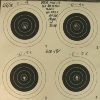“If the gun don’t fit, you won’t shoot it worth shi...”
If extreme accuracy is your goal, then that is true. I don't know about bench rest rifles, but what I have seen in Smallbore prone and in F Class rifles is that ergonomics is extremely important. Point of impact varies by how you hold the rifle, where your face is on the stock, how hard you hit the trigger, and whether you pull the trigger straight back, sideways. Shoot enough Bullseye pistol and you will see the affect of trigger pull on point of impact. Bullseye is one difficult sport. The recoil and blast of a centerfire rifle hide many ills that you will see Smallbore prone, and I have learned from Smallbore that rifle fit is extremely important for consistency. I noticed the good shooters have also figured that out.
I believe this was a good thread, myself, based on my experience, with good ammunition, a good barrel, and good bedding, my rifles will shoot inside my hold. Determining what the error due to my hold, I don't know that number. The error changes, that I do know. There are days when I am shooting Smallbore prone and I feel I can keep them all in the X ring. Of course I don't, but my control is good on those days. I have shot a couple of 1600's. Same gun, same ammunition, similar conditions on a different day, sometimes it is all I can do to hold the ten ring, and of course, I don't. Getting frustrated is a good way to shoot shotgun patterns. Consistency is hard.
Currently I am banging away with a 35 Whelen, and I have noticed, if a round does not feed into the chamber, but I think its there, and I pull the trigger, my scope does a funny dance as I flinch!. With lighter recoiling guns, I do better controlling flinch, but I have seen my flinch, prone with a sling, firing a 22lr Anschutz! It takes work to reduce flinch, and then, you can't keep it away forever. The bigger the bang, the sooner it appears.
There is an interesting article about group size and the number of shots on target in the Oct 2014 Shooting Sports magazine
media/1533525/1014_ssusa_archive.pdf
The last article , page 38, is a reprint of a May 1958 American Rifleman article
"Assessing the Accuracy of 22 lr Target Rifles."
This article is based on test data, it is a very well planned and executed article. Smallbore prone shooters shoot 40 shots per "match", two targets of 20 shots for record each "match", and there are typically three to four "matches" to determine the aggregate. Smallbore prone targets have four record bulls for 50 yards, two record bulls for 100 yards. This is to help the scorer and the shooters.
For the shooter, you need to spread the shots out so you can tell what is happening to the bullets as you shoot. So for small bore, each target is worth 200 points, each match is the aggregate of 40 shots, so for small bore prone shooters, they want perfect 40 shot groups.

Actually they want perfect 160 shot groups, and they want the groups to be less than the X ring in size. What you find, if you ever have your rifle tested at the Lapua test center in Mesa AZ or at Eley, is that lot selected ammunition will hold the ten ring at all distances but not the X ring.
What the article shows is that if a 40 shot group is the standard, then at 50 yards (the analysis goes out to 200 yards) than a 20 shot group is 88% the size of a 40 shot group, a ten shot group 71%, and a five shot group 57% of the size of a 40 shot group. Interestingly, at 100 yards, a prone with a sling group is 38% larger on average than if the group is shot bench rested.
What I have seen with the Bench rest 22lr guys, they are shooting within the inherent accuracy of the ammunition, because they don't hold the rifle. I have seen $1200 front rifle rests, adjustable for elevation and windage, these guys just monkey around with the knobs until the crosshairs are where they want it on the target. At worst they touch the trigger, but pretty much, they don't touch the rifle. Bench rest 22lr guys have one shot targets, if they tried to score a multi shot group on one target, all they would have is one hole, in many circumstances.
The more you practice, the better you hold. However, that really does not mean a dead center hit first shot. I can get into the center with enough sighters, but it is unusual to be dead center first shot. Every range I have shot, I have slightly different zero's on my rifle, and that has to be due to the slightly different geometry of the firing point, how high it is above the target, or below, and that translates into a slightly different hold as I aim. Its very subtle, but it is there.

